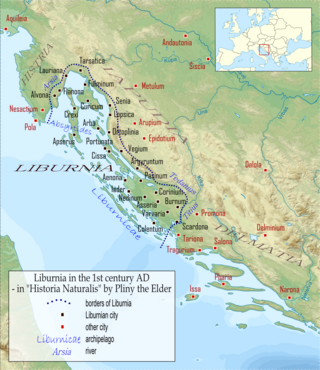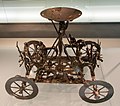
In ancient Greek religion and mythology, Artemis is the goddess of the hunt, the wilderness, wild animals, nature, vegetation, childbirth, care of children, and chastity. In later times, she was identified with Selene, the personification of the Moon. She was often said to roam the forests and mountains, attended by her entourage of nymphs. The goddess Diana is her Roman equivalent.

In ancient Greek religion and mythology, Helios is the god who personifies the Sun. His name is also Latinized as Helius, and he is often given the epithets Hyperion and Phaethon. Helios is often depicted in art with a radiant crown and driving a horse-drawn chariot through the sky. He was a guardian of oaths and also the god of sight. Though Helios was a relatively minor deity in Classical Greece, his worship grew more prominent in late antiquity thanks to his identification with several major solar divinities of the Roman period, particularly Apollo and Sol. The Roman Emperor Julian made Helios the central divinity of his short-lived revival of traditional Roman religious practices in the 4th century AD.

Cybele is an Anatolian mother goddess; she may have a possible forerunner in the earliest neolithic at Çatalhöyük. She is Phrygia's only known goddess, and was probably its national deity. Greek colonists in Asia Minor adopted and adapted her Phrygian cult and spread it to mainland Greece and to the more distant western Greek colonies around the 6th century BC.
Belenus is an ancient Celtic healing god. The cult of Belenus stretched from the Italian Peninsula to the British Isles, with a main sanctuary located at Aquileia, on the Adriatic coast. Through interpretatio romana, Belenus was often identified with Apollo, although his cult seems to have preserved a certain degree of autonomy during the Roman period.

The Veneti were an Indo-European people who inhabited northeastern Italy, in an area corresponding to the modern-day region of Veneto, from the middle of the 2nd millennium BC and developing their own original civilization along the 1st millennium BC.

The Urnfield culture was a late Bronze Age culture of Central Europe, often divided into several local cultures within a broader Urnfield tradition. The name comes from the custom of cremating the dead and placing their ashes in urns, which were then buried in fields. The first usage of the name occurred in publications over grave sites in southern Germany in the late 19th century. Over much of Europe, the Urnfield culture followed the Tumulus culture and was succeeded by the Hallstatt culture. Some linguists and archaeologists have associated this culture with a pre-Celtic language or Proto-Celtic language family. By the end of the 2nd millennium BC, the Urnfield Tradition had spread through Italy, northwestern Europe, and as far west as the Pyrenees. It is at this time that fortified hilltop settlements and sheet‐bronze metalworking also spread widely across Europe, leading some authorities to equate these changes with the expansion of the Celts. These links are no longer accepted.

The Hallstatt culture was the predominant Western and Central European archaeological culture of the Late Bronze Age from the 12th to 8th centuries BC and Early Iron Age Europe from the 8th to 6th centuries BC, developing out of the Urnfield culture of the 12th century BC and followed in much of its area by the La Tène culture. It is commonly associated with Proto-Celtic speaking populations.

Astarte is the Hellenized form of the Ancient Near Eastern goddess ʿAṯtart. ʿAṯtart was the Northwest Semitic equivalent of the East Semitic goddess Ishtar.

Ancient Celtic religion, commonly known as Celtic paganism, was the religion of the ancient Celtic peoples of Europe. Because there are no extant native records of their beliefs, evidence about their religion is gleaned from archaeology, Greco-Roman accounts, and literature from the early Christian period. Celtic paganism was one of a larger group of polytheistic Indo-European religions of Iron Age Europe.

Uni is the ancient goddess of marriage, fertility, family, and women in Etruscan religion and myth, and was the patron goddess of Perugia. She is identified as the Etruscan equivalent of Juno in Roman mythology, and Hera in Greek mythology. As the supreme goddess of the Etruscan pantheon, she is part of the Etruscan trinity, an original precursor to the Capitoline Triad, made up of her husband Tinia, the god of the sky, and daughter Menrva, the goddess of wisdom.

Moccus is a Celtic god who is identified with Mercury. He is the boar- or swine-god of the continental Celtic tribe of Lingones. Moccus was invoked as the protector of boar hunters and warriors. Boar meat was sacred among the ancient Celts, and features in accounts of feasts in Irish mythology. The Lingones, whose tribal center was at modern-day Langres, were a Gaulish tribe located in the area of the rivers Seine and Marne in what is now northeastern France. They were neighbors to the Celto-Germanic tribe of Treveri. Another tribe known as Lingones was located near the mouth of the Po River in northeastern Italy, and were known for agriculture, weaving and metalworking.
In Ancient Greek Religion and mythology, Enodia is a distinctly Thessalian Ancient Greek goddess, identified in certain areas or by certain ancient writers with Artemis, Hecate or Persephone. She was paired with Zeus in cult and sometimes shared sanctuaries with him. Enodia was primarily worshipped in Ancient Thessaly and was well known in Hellenistic Macedonia.
Illyrian religion refers to the religious beliefs and practices of the Illyrian peoples, a group of tribes who spoke the Illyrian languages and inhabited part of the western Balkan Peninsula from at least the 8th century BC until the 7th century AD. The available written sources are very tenuous. They consist largely of personal and place names, and a few glosses from Classical sources.

Delminium was an Illyrian city and the capital of Dalmatia which was located somewhere near today's Tomislavgrad, Bosnia and Herzegovina, under which name it also was the seat of a Latin bishopric.

The Archeological Museum of Eleusis is a museum in Eleusis, Attica, Greece. The museum is located inside the archaeological site of Eleusis. Built in 1890, by the plans of the German architect Kaverau, to keep the findings of the excavations, and after two years (1892) was extended under the plans of the Greek architect J. Mousis.
The Dassaretii were an Illyrian people that lived in the inlands of southern Illyria, between present-day south-eastern Albania and south-western North Macedonia. Their territory included the entire region between the rivers Asamus and Eordaicus, the plateau of Korça locked by the fortress of Pelion and, towards the north it extended to Lake Lychnidus up to the Black Drin. They were directly in contact with the regions of Orestis and Lynkestis of Upper Macedonia. Their chief city was Lychnidos, located on the edge of the lake of the same name. One of the most important settlements in their territory was established at Selcë e Poshtme near the western shore of Lake Lychnidus, where the Illyrian Royal Tombs were built.
Gertus or Gertous was an ancient town in the southern Illyrian region of Dassaretia, mentioned by Polybius in the 2nd century BC in the accounts of the Illyrian Wars and Macedonian Wars. The location of the ancient town is still unknown. It was probably situated between Lychnidus and Antipatrea.

The Labeatae, Labeatai or Labeates were an Illyrian people that lived on the Adriatic coast of southern Illyria, between modern Albania and Montenegro, around Lake Scodra.

The Temple of Artemis or Artemision, also known as the Temple of Diana, was a Greek temple dedicated to an ancient, localised form of the goddess Artemis. It was located in Ephesus. By AD 401 it had been ruined or destroyed. Only foundations and fragments of the last temple remain at the site.


















